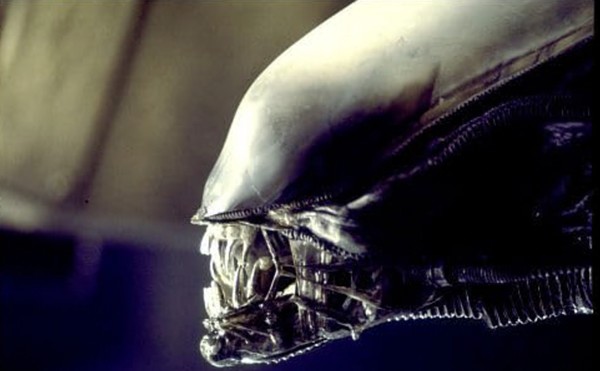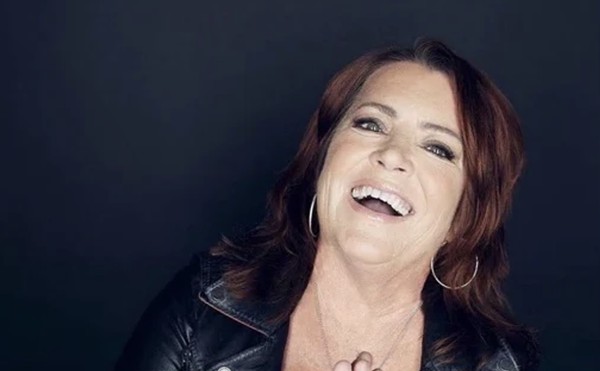Joshua Bienko, Gabriel Vormstein
Free
12-5pm Wed–Sun (on view through May 1)
Artpace
445 N Main
(210) 212-4900
artpace.org
By Scott Andrews on Wed, Jan 26, 2011 at 12:00 am
Joshua Bienko is a trickster, a showman, and a bit of a con artist. His installation Ever So Much More So in WindowWorks gallery at Artpace is high on spectacle, but under all the glitz lies something tentative, almost silent.
The street view exhibition space is a good fit for Bienko, who places fashion — consumer and intellectual — at the luxury end of the market where international art is the gold standard, the super commodity, par excellence. Rather than dropping art works behind the glass like refugees from a white wall gallery, he has turned his commission room into a storefront.
On the glass itself is a brocade-like pattern that the College Station artist has lifted from his own series LOUIS le’Con. Bienko makes style quotes like a gossip columnist drops country club names — this one’s a three-way. The title is a mash-up of Louis Vuitton, whose signature design Bienko has copied as art star Takashi Murakami did before him, and Jacques Lacan, a French psychoanalyst whose theoretical attempts to codify the mechanisms of desire are expressed in Byzantine formulae. Lacan’s name for the unattainable object of desire, objet petit a, appears in symbol as part of the window treatment and as super graphic on the walls inside.
Centered on the wall within, seen unnaturally small and distant from outside the glass barrier though approachable for close view if the room is entered, is the desirable object itself, a pair of black stiletto-heeled shoes by famed designer Christian Louboutin. At $500 a pair, quite likely unobtainable by most. On the shoes’ lipstick-red soles Bienko has painted a view of Jeff Koons’ infamous Balloon Dog sculpture, a work that has become iconic as an emblem of banality and crass commercialism in art. During the exhibition Bienko will rotate this pair with shoes featuring portraits of works by other masters of appropriation: Andy Warhol, Damien Hirst, and the granddaddy of them all, Marcel Duchamp.
Doubling the distance of longing is the predicament facing the lucky consumer who attains these particular patent leather pumps. On the wall, a flashy piece of art. But if you wear them? The painting, done in thick media — almost impasto — would be destroyed. A moment of volupté for the envious artist who might like to stomp out the likes of Jeff Koons, but here, inevitably, the other shoe drops.
Hidden in this play of consumerism and denial is a quiet assertion. The shoes are not covered with images, such as stick-on photos, but paintings. An important oft-forgotten distinction, as it brings to attention process, the artist’s hand, and all that craft tradition sometimes left behind by high concept. That the shoes, and indeed the entire collection of design that makes up the installation, is but a substrate for painting is not a humble view, but rather defiantly romantic. Or perhaps the little paintings, as puny as they are, are the brunt of the joke? The dilemma may appear contrived or false to the viewer, but is real enough to scare the bejeezus out of many artists still slinging paint.
Upstairs in the Hudson (Show)Room is Berlin-based Gabriel Vormstein’s The Teeth of the Wind and the Sea, covering all four walls of the large space with a cycloramic painting rendered on pages of the Frankfurter Allgemeine Zeitung, a German daily newspaper. Here, Romantic tendencies are unambiguous.
On entering the room, the bits copied from works by Egon Schiele, odd van Gogh-like sunflowers or blackbirds, and rough gestural brush strokes seem to impatiently mark the floor-to-ceiling newsprint like out-of-focus graffiti. Only the red square transected by a scribed circle in the center of one of the long walls stands firmly. But after initial confusion the room comes into focus. Like the process of trying to find one’s place after running pell-mell through trees into a forest clearing, pattern slowly emerges. Gazed at broadly, areas of light and dark form repeat in chiaroscuro, though again on closer look, details still dart away from the emerging composition.
The use of newspaper, an ephemeral material that Vormstein has used for the last decade, hints at the strains of duration and inevitable loss that concern the artist. A room off to the side of the large exhibition space is lined with shallow shelves that hold modest sculptural pieces incorporating white plaster with fragments of dead twigs and other detritus. Some are incised with line drawings. Referred to by Vormstein as a grotto, the room and its small works are like a collection of architectural fragments, or relics. Linking the two rooms are common allusions to death and history, but in the room of painting, another affect is dominant. Though references to the past abound, the visual experience holds the present. •
Gabriel Vormstein has exhibited extensively in Europe in many group shows, including the 4th Berlin Biennial of Contemporary Art. This is his first solo museum exhibition and his first project for an American gallery.
Joshua Bienko, Gabriel Vormstein
Free
12-5pm Wed–Sun (on view through May 1)
Artpace
445 N Main
(210) 212-4900
artpace.org

Since 1986, the SA Current has served as the free, independent voice of San Antonio, and we want to keep it that way.
Becoming an SA Current Supporter for as little as $5 a month allows us to continue offering readers access to our coverage of local news, food, nightlife, events, and culture with no paywalls.
Subscribe now to get the latest news delivered right to your inbox.






